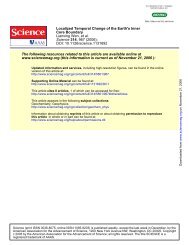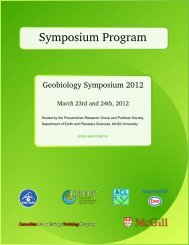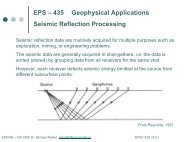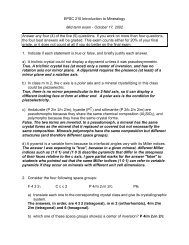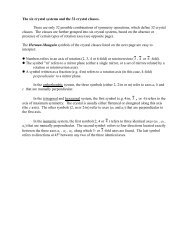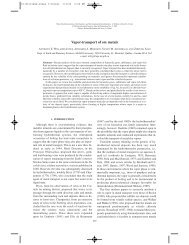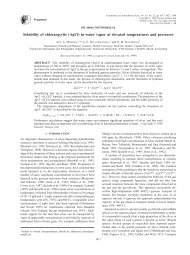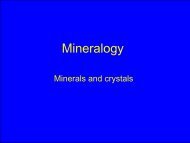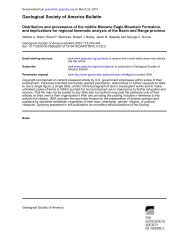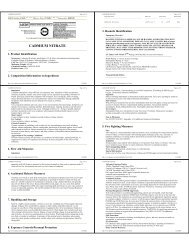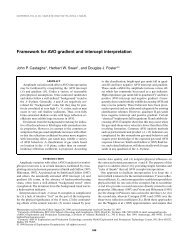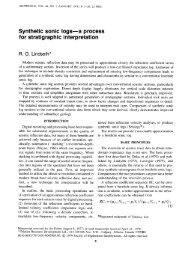05 Classification of.. - Department of Earth and Planetary Sciences
05 Classification of.. - Department of Earth and Planetary Sciences
05 Classification of.. - Department of Earth and Planetary Sciences
You also want an ePaper? Increase the reach of your titles
YUMPU automatically turns print PDFs into web optimized ePapers that Google loves.
86<br />
events (see Chapter 1.07–1.09). Although most<br />
chondrites experienced thermal processing on their<br />
parent asteroids, such as aqueous alteration,<br />
thermal, <strong>and</strong> shock metamorphism, they did not<br />
experience melting <strong>and</strong> igneous differentiation,<br />
<strong>and</strong> thus largely preserve records <strong>of</strong> physical <strong>and</strong><br />
chemical processes in the solar nebula. Deciphering<br />
these records is a primary goal <strong>of</strong> chondrite<br />
studies.<br />
Nonchondritic meteorites lack chondritic textures<br />
<strong>and</strong> are formed by partial or complete<br />
melting <strong>and</strong> planetary differentiation <strong>of</strong> chondritic<br />
precursor asteroids or larger planetary bodies<br />
(Mars, Moon), <strong>and</strong> hence provide unique opportunities<br />
to study these processes on extraterrestrial<br />
bodies (see Chapter 1.11, 1.12, 1.21, <strong>and</strong> 1.22).<br />
Several groups <strong>of</strong> nonchondritic meteorites<br />
experienced only low degrees <strong>of</strong> melting, <strong>and</strong><br />
have largely retained their chondritic bulk compositions.<br />
To emphasize the relatively unprocessed<br />
nature <strong>of</strong> these nonchondrites <strong>and</strong> their<br />
intermediate status relative to chondrites <strong>and</strong><br />
highly differentiated meteorites, they are referred<br />
to as primitive achondrites <strong>and</strong> discussed as a<br />
separate category <strong>of</strong> nonchondritic meteorites.<br />
1.<strong>05</strong>.2 CLASSIFICATION OF CHONDRITIC<br />
METEORITES<br />
1.<strong>05</strong>.2.1 Taxonomy<br />
Based on bulk chemistry (Figures 2 <strong>and</strong> 3),<br />
bulk oxygen isotopic compositions (Figure 4),<br />
mineralogy, petrology (Figures 8–13 <strong>and</strong> 15), <strong>and</strong><br />
proportions <strong>of</strong> various chondritic components<br />
(Table 2), 14 chondrite groups have been<br />
recognized. Several other chondrites are mineralogically<br />
<strong>and</strong>/or chemically unique <strong>and</strong> defy<br />
classification into the existing chondrite groups;<br />
these are commonly called ungrouped chondrites<br />
(Table 1 <strong>and</strong> Figure 1).<br />
Conventionally, a chondrite “group” is defined<br />
as having a minimum <strong>of</strong> five unpaired chondrites<br />
<strong>of</strong> similar mineralogy, petrography, bulk isotopic<br />
properties, <strong>and</strong> bulk chemical compositions in<br />
major, nonvolatile elements. According to this<br />
definition, K chondrites could be considered as a<br />
grouplet: there are only two known K chondrites<br />
(see K (Kakangari-like) chondrites).<br />
Thirteen out <strong>of</strong> the 14 chondrite groups<br />
comprise three major classes: carbonaceous (C),<br />
ordinary (O), <strong>and</strong> enstatite (E), each <strong>of</strong> which<br />
contains distinct groups.<br />
The term carbonaceous is somewhat <strong>of</strong> a<br />
misnomer, because only the CI, CM, <strong>and</strong> CR<br />
chondrites are significantly enriched in carbon<br />
relative to noncarbonaceous chondrites (Figure 5).<br />
The CI chondrites lack chondrules. Carbonaceous<br />
<strong>and</strong> noncarbonaceous chondrites can be resolved<br />
<strong>Classification</strong> <strong>of</strong> Meteorites<br />
(with some exceptions) by several characteristics:<br />
(i) mean refractory lithophile/Si abundance<br />
ratios relative to CI chondrites ($1.00 in carbonaceous<br />
chondrites, #0.95 in noncarbonaceous<br />
chondrites); (ii) oxygen isotopic composition<br />
(D 17 O #22‰ for carbonaceous chondrites,<br />
except CI; D 17 O$21‰ for noncarbonaceous<br />
chondrites); (iii) refractory inclusion abundances<br />
($0.1 vol.% in carbonaceous chondrites, except<br />
CI; #0.1 vol.% in noncarbonaceous chondrites);<br />
<strong>and</strong> (iv) matrix/chondrule modal abundance ratio<br />
($0.9 in carbonaceous chondrites, except CH <strong>and</strong><br />
CB; #0.9 in noncarbonaceous chondrites, except<br />
K chondrites) (Kallemeyn et al., 1996).<br />
There are eight well-resolved groups <strong>of</strong> carbonaceous<br />
chondrites: CI, CM, CR, CH, CB, CV,<br />
CK, <strong>and</strong> CO. The letters designating the groups<br />
refer to a typical chondrite (commonly fall)<br />
in the group: CI (Ivuna-like), CM (Migheilike),<br />
CO (Ornans-like), CR (Renazzo-like),<br />
CH (ALH85085-like), CB (Bencubbin-like), CV<br />
(Vigarano-like), <strong>and</strong> CK (Karoonda-like). The<br />
exception to this rule is the CH group, in which the<br />
“H” refers to high metal abundance <strong>and</strong> high iron<br />
concentration (Bisch<strong>of</strong>f et al., 1993b).<br />
Ordinary chondrites are divided into three<br />
groups: H, L, <strong>and</strong> LL. The letters designating the<br />
groups refer to the bulk iron contents: H chondrites<br />
have high total iron contents, L chondrites have<br />
low total iron contents, <strong>and</strong> LL chondrites have<br />
low metallic iron relative to total iron, as well<br />
as low total iron contents.<br />
Enstatite chondrites comprise two groups with<br />
different contents <strong>of</strong> metallic iron: EH <strong>and</strong> EL.<br />
Additionally, there is an ungrouped E chondrite,<br />
LEW87223 (Grossman et al., 1993).<br />
R (Rumuruti-like) <strong>and</strong> K (Kakangari-like)<br />
chondrite groups are different from other chondrites<br />
<strong>and</strong> have been suggested to represent<br />
additional chondrite classes.<br />
The term clan is used as a higher order <strong>of</strong><br />
classification than group. It was originally defined<br />
to encompass chondrites that have chemical,<br />
mineralogical, <strong>and</strong> isotopic similarities <strong>and</strong> were<br />
believed to have formed at about the same time in<br />
the same small region <strong>of</strong> the solar nebula, in a<br />
narrow range <strong>of</strong> heliocentric distances (Kallemeyn<br />
<strong>and</strong> Wasson, 1981; Kallemeyn et al., 1996).<br />
Weisberg et al. (1995a) used the term for<br />
chondrites that have chemical, mineralogical,<br />
<strong>and</strong> isotopic similarities suggesting a petrogenetic<br />
kinship, but have petrologic <strong>and</strong>/or bulk chemical<br />
characteristics that challenge a group relationship.<br />
Four carbonaceous chondrite clans have been<br />
recognized: (i) the CR clan, which includes the<br />
CR, CH, CB, <strong>and</strong> a unique chondrite LEW85332;<br />
(ii) the CM–CO clan; (iii) the CV–CK clan;<br />
<strong>and</strong> (iv) the CI clan (Kallemeyn et al., 1996).<br />
The noncarbonaceous chondrites constitute three<br />
clans: OþR, E, <strong>and</strong> K.



